by Morgan Lewis | May 15, 2019 | Blog
News Flash: There is a lot of written content on the web. That means it is challenging to grab a reader’s attention and even more difficult to hold it. One study, from way back in 2014, found online readers generally click away after 15 seconds. Five years and billions of smartphones later, it’s probably closer to 12 or 11 seconds.
That’s why when creating PR or marketing content, we constantly need to consider the reader first. Certainly, companies have their own goals for every content piece they create, but the reader’s experience, what’s meaningful to them and their goals for reading your content must be the first priority.
Here’s how to grab a reader’s attention in written content and hold it to the last word.
Identify your reader
This is the most important question. Whether crafting a thought leadership article, email blast or white paper, it needs to be laser-focused on who the reader is because as soon as they sense a piece of content isn’t relevant to them, they’ll delete, click or scroll away to something else. It’s a tougher question than it appears. If you set your sights too narrow, you risk alienating a lot of prospects; if you aim too broad, you risk being ignored by everybody.
Headline and lead paragraphs are the most important
What did you think of the headline for this blog post? Did it pique your curiosity? If so, good, because that’s what headlines need to do. Readers typically decide to continue an article after the headline and first few lines, so these two introductory elements are perhaps the most important parts of the content in most writing.
Style matters
The type of content will often dictate what style you use for your headline and lead as well as for other writing choices. A blog post, like the one you’re reading, allows for a little more causal headline, lead and language, but regardless of the style, it needs to be relevant and easy to read. Longer pieces, like white papers, should also move the reader along, even if they are written in a more formal style.
Tell the reader why they should stick with you
There are many ways in those lead paragraphs to encourage the reader to keep reading. Options include presenting a common, pressing problem that they want to solve, asking a provocative question that they will want to answer, or enticing them with ROI. For example, in B2B (and even in B2C) dollar signs always grab readers’ attention. Obviously, if the content has no financial element, then that’s not feasible, but sharing quantifiable numbers automatically establishes interest and often relevance in the reader.
Make every paragraph meaningful
Keep the reader engaged through the entire content piece by putting information in every paragraph that they care about or include actionable data they can begin applying today. The overriding goal of PR and marketing content is, of course, to attract prospects, but writing about only your solution is a turn-off, even presented in a vendor-neutral fashion.
One size does not fit all
I was going to title this subhead: “keep it short,” but one study shows that a 1,600-word length for most pieces is ideal, even for blog posts. Other research contradicts that finding. For a white paper, eBook or byline, that length or longer seems appropriate, but with blog posts, we say keep them shorter and then drive the reader to download the longer content piece.
What nearly all the research says, however, is if it is quality content, the reader will stick with it, regardless of length. In healthcare B2B PR, which is where we at Amendola Communications live, quality content means relevance to the reader, their job or their business. Stay on that track and you’ll have them reading to the last word, which is what I hope you’re doing right now.
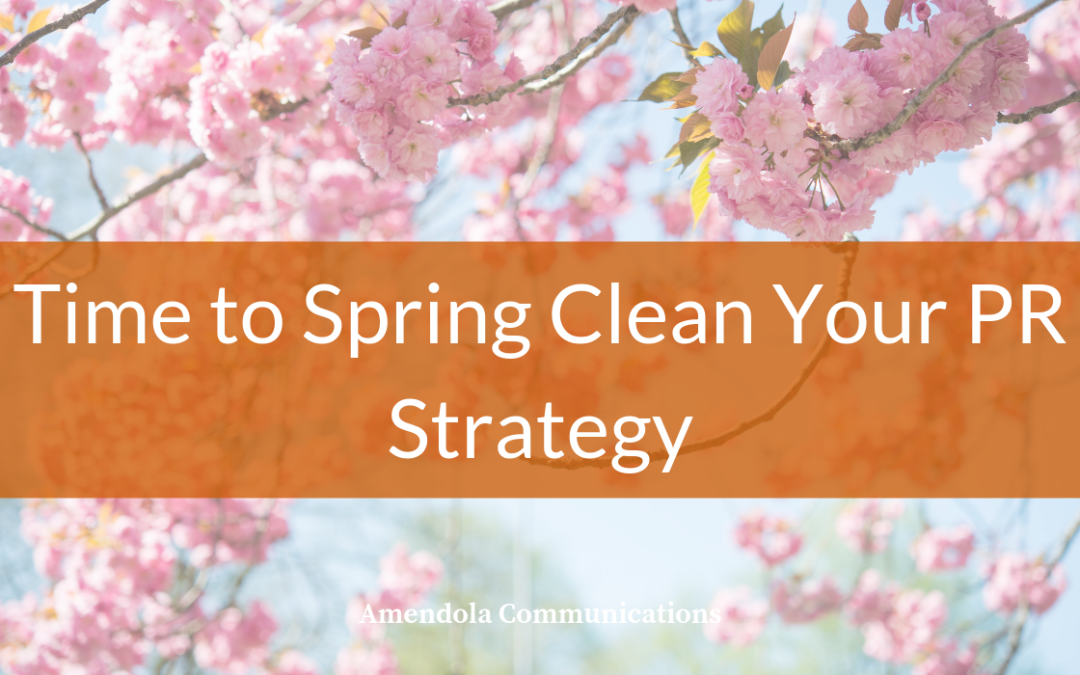
by admin | May 8, 2019 | Blog
The sun is shining, the birds are chirping, and the flowers and trees are blooming. It’s that time of the year when I think about Spring cleaning, especially living in Atlanta where everything inside and out is covered in pollen. As I was dusting my entire house last weekend trying to rid it of the fine yellow dust covering EVERYTHING (the struggle is real y’all); I started thinking about how to spring clean your PR strategy and what would benefit the most from a little extra attention.
Media Lists
The media landscape is constantly in transition. Journalists change positions, beats, contact information, etc. They might have altered their interest in specific topics. Throughout the year, we try to keep our press lists up-to-date, but spending some extra time going over your media list, updating the notes based on feedback from pitches and researching new media outlets can be a great use of time.
Messaging
This is a great opportunity to review your business’ messaging and assess if it needs updating. Perhaps you’ve announced new products in the last six months, or perhaps the industry has developed a new acronym for your niche, or maybe there is a new piece of healthcare legislation that is key to what your business does that should be mentioned in your messaging. Maybe you’ve learned more throughout the year about what your key audiences want to hear. Now is a great opportunity to take another look at your key messages to make sure they are conveying what you want them to and effectively reaching your target audiences.
PR Coverage
With a fresh look at your media lists and messaging, it would also be timely to review your coverage. Where have you received the most placements? Are any angles played out at this point? What outlets have you not gotten coverage in that you want to be in? What angles do you need to push harder? Are you actually reaching your target audiences with these outlets? A review of all of this will help you spring forward to make your coverage blossom even more.
Events
We PR people like to develop our annual plans generally at the beginning of each year. But so many details for events such as conferences and tradeshows are updated throughout the year. Determining which conferences you plan to attend, submit a speaker application to or want to include in your content strategy is a key component to any PR campaign. Take this time to update your events list with deadlines for speaking and any other promotional activities.
Review and Set New Goals
With a fresh perspective on where you’ve been and what you have to work with, it is also a great time to review the progress you’ve made in achieving your goals and updating them or maybe upgrading them. Utilize the S.M.A.R.T. goal format as a best practice.
Some of these recommendations take some ongoing maintenance but think of this time as a chance to really dust off what you are doing with your PR campaign and apply a fresh strategic approach to it. So, before you grab a vacuum, go grab a pen and review your PR strategy to help your business make the most of its PR activities.
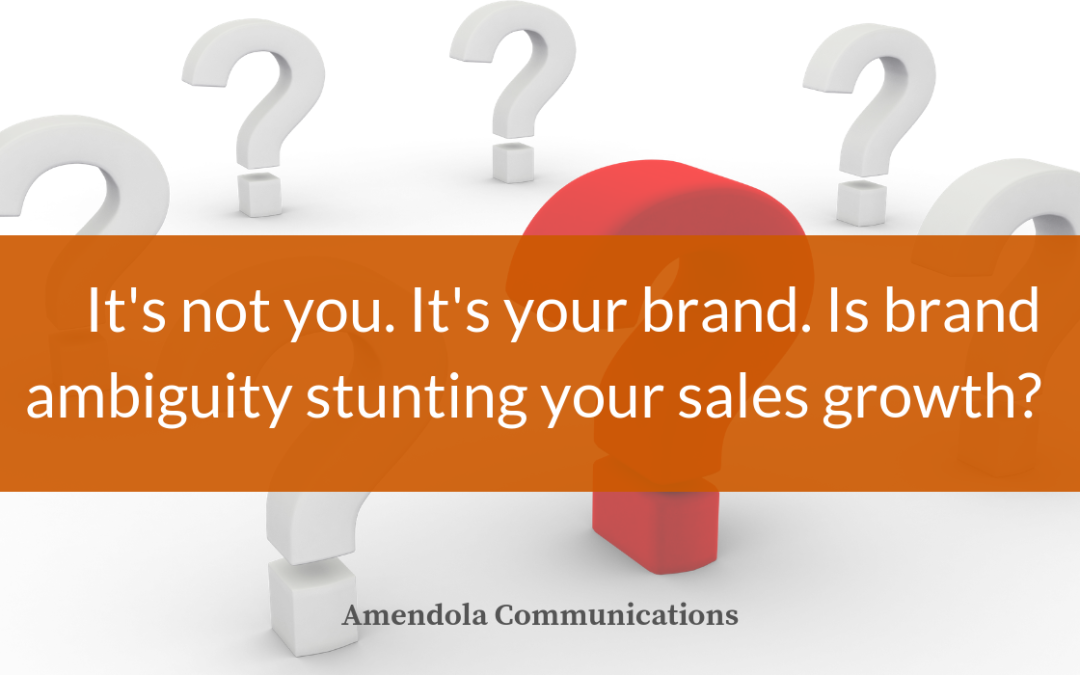
by Jenn Cohen | May 1, 2019 | Blog
Over the last fifteen years, I’ve participated in more corporate messaging workshops than can be counted. Inevitably, at a certain point during the workshop, the facilitator will ask the collective group: “Who ARE we?” Typically, the marketing leaders are quick to reiterate the company’s vision or mission statement, while sales leaders rattle verbiage from their elevator pitches, and executives state messages similar to those they give investors on analyst calls. Turns out, answering “Who ARE we?” is not that simple of a question after all.
Is your brand suffering from a bit of ambiguity? Try this simple experiment the next time you’re riding up the elevator with colleagues. Ask the folks standing beside you, “Who is {insert your company name here}?”
I’m not a gambler, but I’d wage a bet you’d get limited overlap in responses. Why? Perhaps because your organization hasn’t fully invested the time and effort into crystalizing their brand positioning and brand purpose for all employees, customers and stakeholders.
No longer reserved for consumer-facing brands, it has become essential for business-to-business organizations to not only create and develop a brand but also define their position and purpose. Why?
Not only will it separate your brand from a sea of sameness among competition, but it can elevate your position in the market. If we as marketers can prevent our sales team from being asked “So who are you, again?” we’ve done part of our job.
I’ve worked on branding and rebranding initiatives for companies of all sizes and what do they all have in common? An aligned purpose to create a great brand.
But what does it take to go from good to great? Well, good brands merely fulfill a need. They provide a service, or a product, based upon an expressed need.
But a great brand? A great brand anticipates. How? By truly understanding their customers. Talking to them. Asking questions. Reading about them in the news. Thinking about their current and future needs.
And while it may be unpleasant, or downright excruciating, asking your customers where your brand falls short can be one of the first steps towards creating a brand people trust. After all, people want partners, not vendors.
Sometimes the most important part of creating and maintaining a successful brand is simply realizing that just because something isn’t broken doesn’t mean it’s working. In the last year alone, we’ve seen notable brands take inventory of their brand presence and come to the ultimate realization that their current identity is no longer aligned with their future state. Let’s look at three notable examples:
Dunkin Donuts ditched the donuts and debuted a short name Dunkin along with a modernized look and feel to test stores around the country earlier this year. The company is investing $100 million to update their stores and “better meet the evolving tastes” of their customers, which will include new equipment and dedicated drive-through lanes so people who order drinks on their phones (hello, Starbucks!) can pick them up easily. They realized the market demanded more than coffee and donuts to stay competitive, and they’re putting their money where their mouth is.
Unlike Dunkin’, Slack kept their name but instead chose to revamp their original (dare I say iconic?)logo. This move caused an onset of conversation around the decision to ditch the beloved hashtag in favor of a simpler visual identity. Why? They felt it was time to evolve. Beyond the unexpected logo swap, Slack’s rebrand came in advance of a direct public offering expected later this year.
Earlier this year, WeWork announced their rebrand, informing the market that they will now be known as We Company. This strategy was likely designed for both investors and customers in order to broaden their aspirations from places to people. The announcement also came with a sweet perk to the tune of $2 billion in investment from SoftBank Group.
Taking inventory of your current brand and determining whether it aligns with your future growth is no easy feat. In part two of this post, we’ll review the main drivers that help indicate when a logo refresh is needed, a repositioning workshop will do, or when a full rebrand makes the most sense.
We’ll walk through logical next steps, including how to get it done. Using your brand as a springboard to add colorful depth to your offerings can easily change the conversation and help your sales team create meaningful relationships to not just power the sales cycle but build the funnel at the same time.
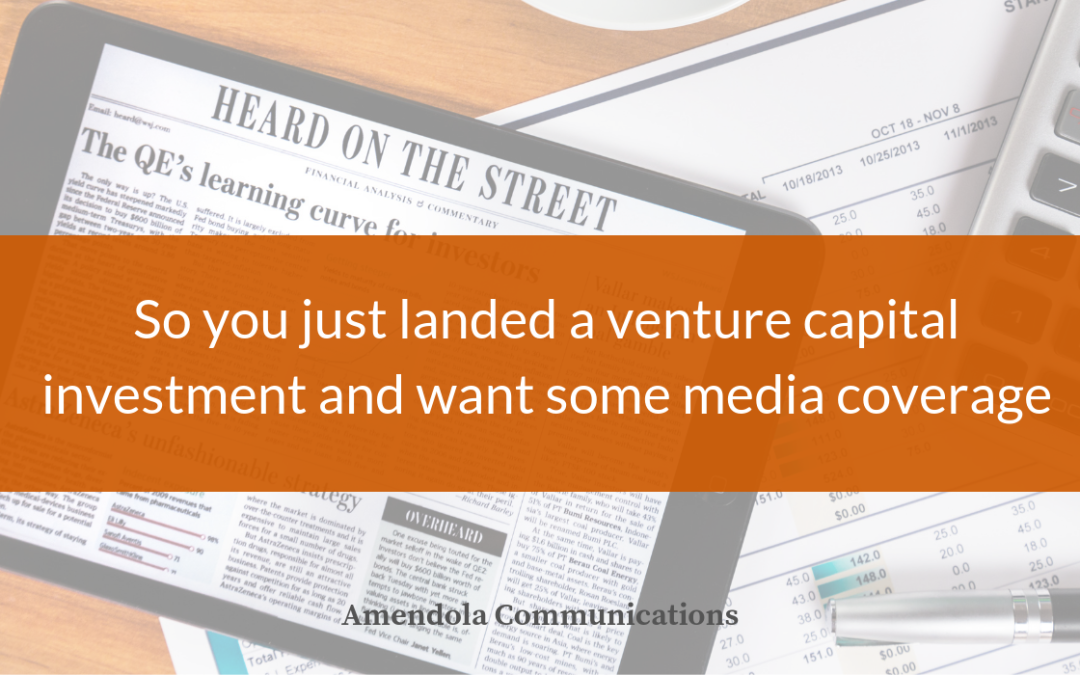
by Brandon Glenn | Apr 24, 2019 | Blog
Closing a venture capital (VC) investment is a big deal for any young company.
After all, less than 1 percent of all U.S. companies receive VC money. A VC investment represents market validation. An experienced group of industry veterans has decided that your company holds the promise and potential to make them (and maybe even yourself and a few of your employees) rich. They think you have an innovative idea, and their cash will serve as the catalyst sparking that growth.
Sounds great and it is. Landing VC money is a huge accomplishment for any company that is able to make it through what is generally an ultra-competitive process.
It’s also a great opportunity to generate some media coverage, which for many young companies, will represent their first introduction to the market and first occasion to share their stories with potential customers, partners, acquirers and other investors.
The only problem? Announcements of VC investments happen all the time, so the media is not lacking in coverage options. To make sure your announcement about obtaining a venture capital investment gets noticed, keep these four integral principles in mind.
Do not withhold the dollar amount: If you’re looking to create media interest at all, I cannot stress enough the importance of including the dollar amount of the investment. This is a very important point for reporters who need some way of assessing the gravity of all the funding announcements they see. Obviously, $50 million will look better in headlines than $5 million, but $1 million looks a lot better than nothing. In my reporter days, when I saw a funding announcement without a dollar amount, it immediately went to the bottom of my queue of potential upcoming stories. Don’t fumble away this valuable opportunity by failing to get approval from your investors to include the dollar amount.
Describe how you’ll use the investment: All reporters expect that you’ll use your recent cash infusion to drive “growth,” but they’ll want more specifics than that. What are your key measures of growth? If it’s customer acquisition, what type of customers are you looking to acquire? If it’s employee headcount, how many are you looking to hire? (BONUS: Including potential jobs numbers in an area can help you get into local media AND aid in your recruiting efforts.) If it’s revenue, by what percentage are you hoping to grow revenue in the next year? Obviously, you don’t want to reveal any secret strategies to competitors, but your investment announcement provides an opening to begin shaping your company’s story and the way it’s publicly perceived. Do that by articulating a clear vision for the future that describes exactly what “growth” means to you.
Make sure executives are available for interviews on the day of the announcement: For the chance to pose questions like those mentioned above plus plenty more reporters will be interested in speaking with a top company executive, preferably the CEO. After coordinating key talking points with the CEO, be sure to coordinate schedules. As important as a funding announcement is, it’s not realistic to expect an executive to block off her entire day for interviews. But one or two decent chunks of time on the day of the announcement isn’t too much to ask.
Be sure to include investor and customer quotes: A VC investment serves as an important representation of market validation, and the funding announcement is a chance to shout that validation from the rooftops. A quote from the investor is a must, explaining why the VC firm thinks this company is one to take a risk on, why the market will ultimately choose their technology as a winner and what type of growth potential exists in this particular market niche. For bonus points, include a customer quote explaining (preferably with quantifiable outcomes) exactly how your technology helped them address a significant business problem.
Yes, it can be difficult to gain media coverage for venture capital announcements due to all the stiff competition out there. But it is possible to get journalists’ attention.
Drafting an announcement that follows the key principles above will help your announcement stand out while giving journalists what they want and need – a good, complete story to tell. And the same story that helped you win the investment in the first place.
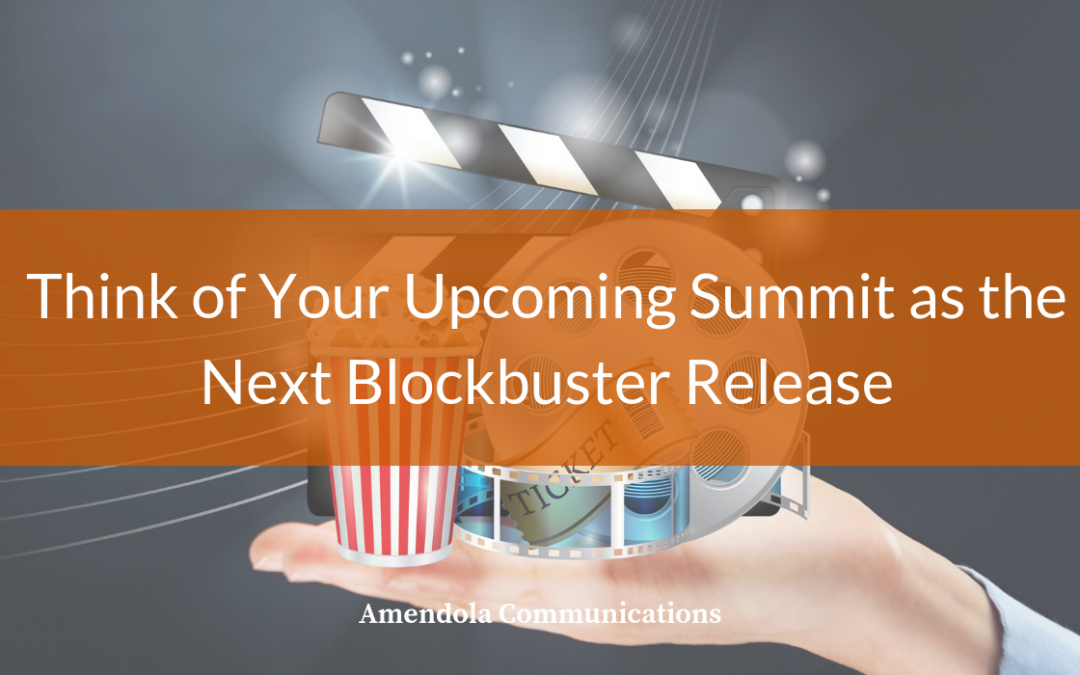
by Chris Currington | Apr 17, 2019 | Blog
You’ve invested substantially in your upcoming trade shows, congresses, conferences or summits (collectively referred to as “summits” in this blog piece). Speaker submission forms. Sponsorships. Booth-install, technology and set-up. Videos. Meeting spaces. Air fare. Hotel blocks. Meals and entertainment. Just to name a few of the common and worthwhile expenses.
But, how do you make your speakers stand out from the others? How will you pique interest and draw attendance? How can you show target audiences the value in your solution and engage with them?
Think about your upcoming summit as if you were bringing a new movie to theaters building anticipation and excitement for your specific offering, making sure your audience gets an entertaining learning experience and then at the end leave them wanting more.
1. Coming Soon! (Build Anticipation)
You should begin preparing months in advance of the summit. If possible, make sure the save-the-date goes out to key audiences (including internal sales and marketing teams) during the previous year’s summit. If that isn’t possible, then send out the save-the-date as soon as your appearance at a summit or a speaking opportunity is secured.
During the months leading up to it, create talk tracks for sales and account teams to help drive attendance to the summit. Talking points can also be used in emails to clients, customers and prospects. Develop landing pages and digital flyers with information about the summit and speaker.
Something to keep in mind is, if you’re securing speaking sessions or educational forums, make sure they offer continuing education credits. This helps to build interest in your key audiences and leads to better attendance.
As the show draws closer, supply your sales and account teams with social media posts that they can easily post and share. These take only minutes to compose and can be a simple push to their Twitter, LinkedIn and Instagram accounts.
2. Showtime! (Creating a Meaningful Experience)
From the time the summit opens, you should be taking advantage of opportunities to engage your appropriate audiences. There are various media and formats to create a dialogue and draw attention to your company and solution offering.
If it’s allowed, during keynotes and other speeches, you could consider live-streaming them for your customers, clients and prospects who are unable to attend. This is also a great way to create a “pull” and desire to attend the show in the future.
For social media, make sure that you have an ambassador who is taking pictures and writing recaps of sessions that link to next year’s save-the-date for the show. Include something in the social post like, “Reserve your spot NOW for next year’s summit!”
If you have clients on-site, help them share their stories through testimonials. You can also have a videographer, who is visible to other attendees, grabbing people in the hallway or aisles and asking them about their conference experience, what they’ve learned and their most important takeaways. This is an excellent way to create buzz and get people talking. It also provides content for a recap video to promote future conferences and can be an amazing tool for digital campaigns.
Be sure to have a booth or pop-up in the vendor display area. In addition to having a space to demonstrate your solution, this gives you a meeting area for clients to discuss their successes and prospects to ask questions and sign up to learn more. And, make sure that sales and account management teams are taking notes so they can conduct proper follow-up opportunities. To keep attendees engaged and returning to your booth, consider some sort of raffle or giveaway.
If you have speakers and clients presenting, create polls during the sessions. This gives another chance to engage the audience and gives you statistics and material to post on social media. Build in an appropriate time for questions and answers those, too, can be posted on social channels. For future material, assign writers to record the sessions and create bylines or post-session articles to add to your marketing content pipeline for months to come.
3. Now Streaming! (Post Show Tactics and After Effects)
As soon as the show ends, issue a press release with a recap of any important announcements, how many people attended, a list of organizations that attended (if it’s impressive) and any awards that may have been given to your customers or clients. Be sure to include client quotes”¦especially those related to your product or solution.
Create a virtual summit, in a webinar format, with a series of the best sessions. You may need to fill out forms and work with the show’s continuing education people, but it may be possible to offer continuing education for the virtual summit as well.
For those who attended the summit, consider creating a gated microsite, with links to all materials from the show’s sessions, and a link to the next year’s save-the-date. You can also include links to the virtual summit schedule, registrations and the media recap session that was produced during the show (or post-show) as well.
Finally, email your target list to keep them engaged! Develop a cadence of one-a-month, with key takeaways, follow up materials and calls to action.
To get the most from the investment you’ve made in summits, have a strategy and devote the time to plan, execute and follow-up. Remember that the latest big blockbuster movie had many resources devoted to its preparation and release, as well as continuing its popularity after it left theaters. With the tactics in this blog, hopefully you, too, will have a summit that’s a hit for a long time to follow and attracts audiences to many sequels.
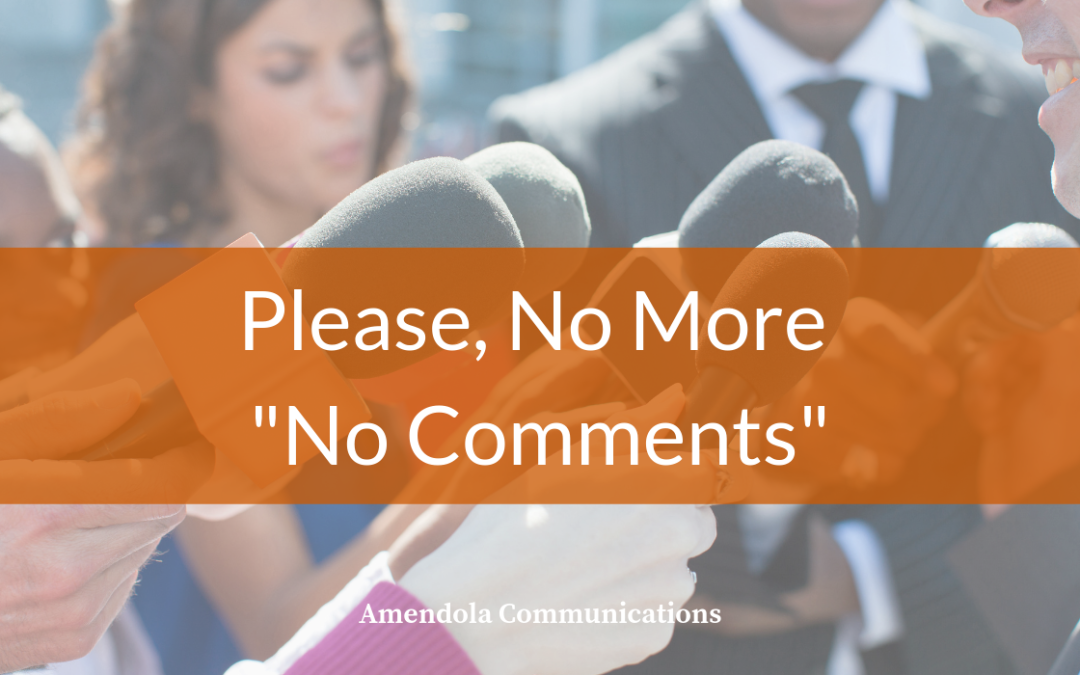
by Stephanie Janard | Apr 10, 2019 | Blog
By now it should be settled: when confronted by an inquiring reporter, never ever respond with “No comment.” Just don’t, no matter how uncomfortable a question makes you. As others before me have emphatically noted there is no faster way to make a reporter instantly suspicious. And the public, if the reporter decides to publish your “no comment.”
Yet companies keep saying it. Over and over and over. And so, we must keep advising they not. I polled a number of my colleagues here at Amendola Communications for their thoughts on alternatives to a phrase that’s anathema to the media and public alike.
When you are approached by a reporter and there is a temptation to respond “no comment” that usually means it’s a negative story. But by commenting you have an opportunity to contain, control, or redirect the narrative to something more favorable,” observes Ken Krause, senior account director at Amendola.
Otherwise, he adds, by responding “no comment” you are leaving it to others to fill in the blanks.
“And they may do it in a way that is not only bad for your organization but incorrect; at which point you’ll have to do full-on damage control. But the horse is already out of the barn,” Ken warns.
It’s also just a plain off-putting statement that comes across as dismissive and even arrogant.
“You’re actually better not commenting than saying no comment. that said, a response of some sort is almost always better,” Tara Stultz, VP at Amendola advises.
As for what that response should be, it hinges on a multitude of scenarios. But honesty is the crucial ingredient in any response, even if your comment is more or less a brief one noting that your company is still in the fact-finding stage.
“In a crisis situation, you really do need to have an answer, even if it’s a non-answer initially. If a reporter is trying to get someone to dish on a story they aren’t ready to release, saying we aren’t ready to discuss at this time’ or we will be ready to discuss it at a later date’ I think is perfectly acceptable,” shares Linda Healen, senior account director at Amendola.
Even a “I can’t comment at this time” is softer than “no comment.” But follow it with a reason why. In healthcare, for example, companies are sometime asked about specific patient cases, which by law they can’t discuss without a patient’s express, written permission.
“In that case, it’s fine to note that you can’t comment due to HIPAA privacy requirements, but you could follow by noting some trends in general that apply to that situation,” recommends Megan Smith, senior account director at Amendola.
Of course, the best way to increase the chance you’ll give the best possible answer is to plan ahead for questions that could otherwise catch you off guard. That’s why at Amendola we place a lot of importance on messaging, media training, and crisis communications drills. In today’s fishbowl climate, these are elements that every organization should cultivate. If you haven’t yet, give us a call. We’re here to help!




